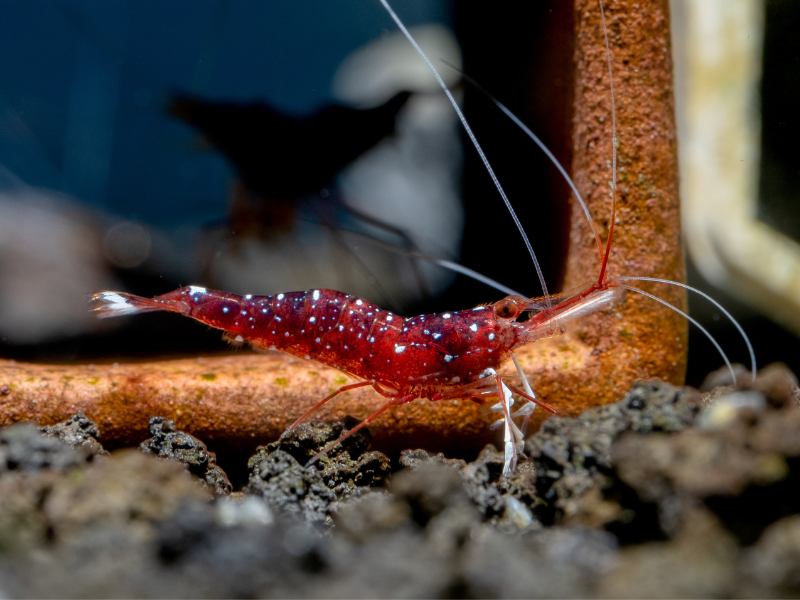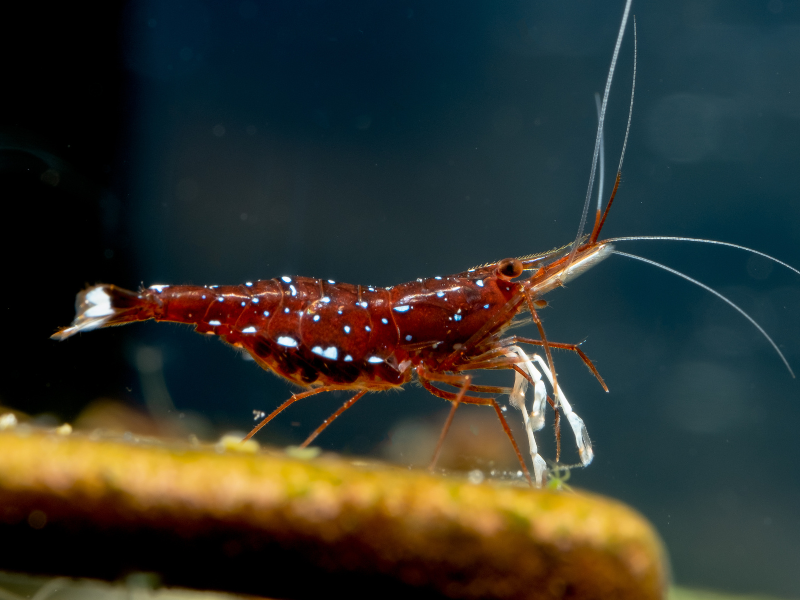Caridina dennerli
Cardinal Shrimp

Scientific Classification
Quick Stats
Aquarium Building Information
About This Species
Basic Description
Detailed Description
Caridina dennerli is a captivating species for the experienced aquarist, originating from the ancient tectonic lakes of Sulawesi, Indonesia. Replicating this unique natural habitat is the key to successfully keeping them. These lakes are characterized by exceptionally stable parameters, including very warm temperatures and a high pH, which must be consistently maintained in the aquarium. Drastic or frequent fluctuations in water chemistry are a primary cause of stress and mortality. Therefore, a dedicated, species-only tank is highly recommended. The aquarium should be well-established, with ample surface area for the growth of biofilm and algae, which constitute the bulk of their diet. Rocks, driftwood, and inert substrates provide ideal surfaces for this microbial growth. While they are efficient grazers, their diet should be supplemented with high-quality sinking pellets, wafers, and other specialized shrimp foods to ensure complete nutrition.
These shrimp exhibit a shoaling nature and feel most secure in large groups. A sizable colony will encourage more natural, less reclusive behavior, with individuals actively exploring their environment at all hours. They are constantly in motion, moving across the bottom and middle levels of the tank as they forage. Despite being active, their metabolism is slow, and they produce a very low amount of waste. However, this does not reduce the need for impeccable water quality; they are extremely sensitive to ammonia, nitrites, and even low levels of nitrates. Water flow should be gentle to mimic the lacustrine conditions of their home environment. Due to their peaceful disposition, small size, and specific water needs, they are not suitable for a typical community tank. Any tank mates must be chosen with extreme care to avoid predation and competition.
Scientific Description
Caridina dennerli is a small decapod crustacean belonging to the family Atyidae, a diverse group of freshwater shrimp found worldwide. Endemic to Lake Matano in Sulawesi, Indonesia, this species is adapted to a unique and stable lacustrine environment with warm, alkaline, and mineral-rich waters. Its morphology is characterized by a laterally compressed body (compressiform), typical of many shrimp species. As a member of the genus Caridina, it plays a specific ecological role within its habitat.
Ecologically, C. dennerli is a benthic and epibenthic grazer, functioning as a primary consumer. Its diet consists predominantly of biofilm, algae, and detritus, making it an important part of the nutrient cycling process within its ecosystem. By consuming this organic matter, it helps transfer energy up the food chain and maintain the health of the benthic zone. Physiologically, it is adapted to its warm-water environment with a low metabolic rate and very low oxygen consumption, traits that are beneficial in a thermally stable habitat. Its waste production is minimal, resulting in a low bioload factor, which signifies its minor impact on nitrogenous waste accumulation relative to its size. The species is listed as Endangered on the IUCN Red List due to threats including habitat degradation from pollution and the environmental impact of nickel mining, as well as over-collection for the aquarium trade. This conservation status underscores the importance of sustainable, captive-breeding efforts to reduce pressure on wild populations and preserve the species.
Breeding Description
Successfully breeding the Cardinal Shrimp is considered a difficult endeavor that demands a pristine and highly stable aquatic environment. The primary challenge lies not in the reproductive process itself, but in maintaining the specific water parameters required for both adults and offspring to survive. Visual sexing of Caridina dennerli is extremely difficult, as there are no prominent external differences between males and females. The most reliable method to ensure reproduction is to establish a large, healthy colony of at least ten to twenty individuals, which increases the probability of having a good ratio of both sexes.
This species is a direct breeder, meaning the female carries a clutch of eggs under her abdomen until they hatch. This state is commonly referred to as being "berried." The incubation period is dependent on temperature but typically lasts several weeks. Once the eggs are ready, they hatch into fully formed, miniature versions of the adults, completely bypassing any larval stages. This is a significant advantage for the aquarist, as no special larval rearing is required. The newly hatched shrimplets are incredibly small and vulnerable. They do not require separation from the parents, as the adults do not predate on their young. The best chance of survival for the shrimplets is to be born in a well-matured aquarium with an abundance of natural food sources. A tank rich in biofilm, soft algae, and other microorganisms provides the essential first foods they need to graze on. The aquarist can supplement this with finely crushed or powdered shrimp food to ensure ample nutrition is available for the entire colony. Maintaining unwavering water stability is the most critical factor for the survival and development of the young shrimp.
Sexual Dimorphism
Generate Printable Card
Create a printable card for this creature to display in your store or aquarium. The card includes a QR code for quick access to more information.













